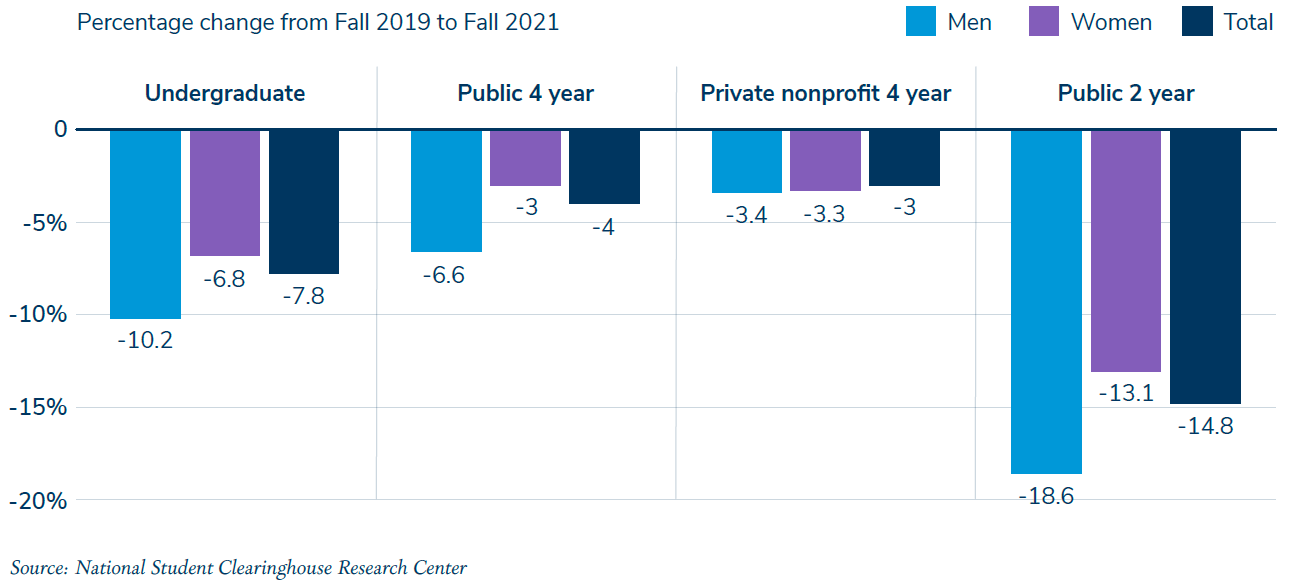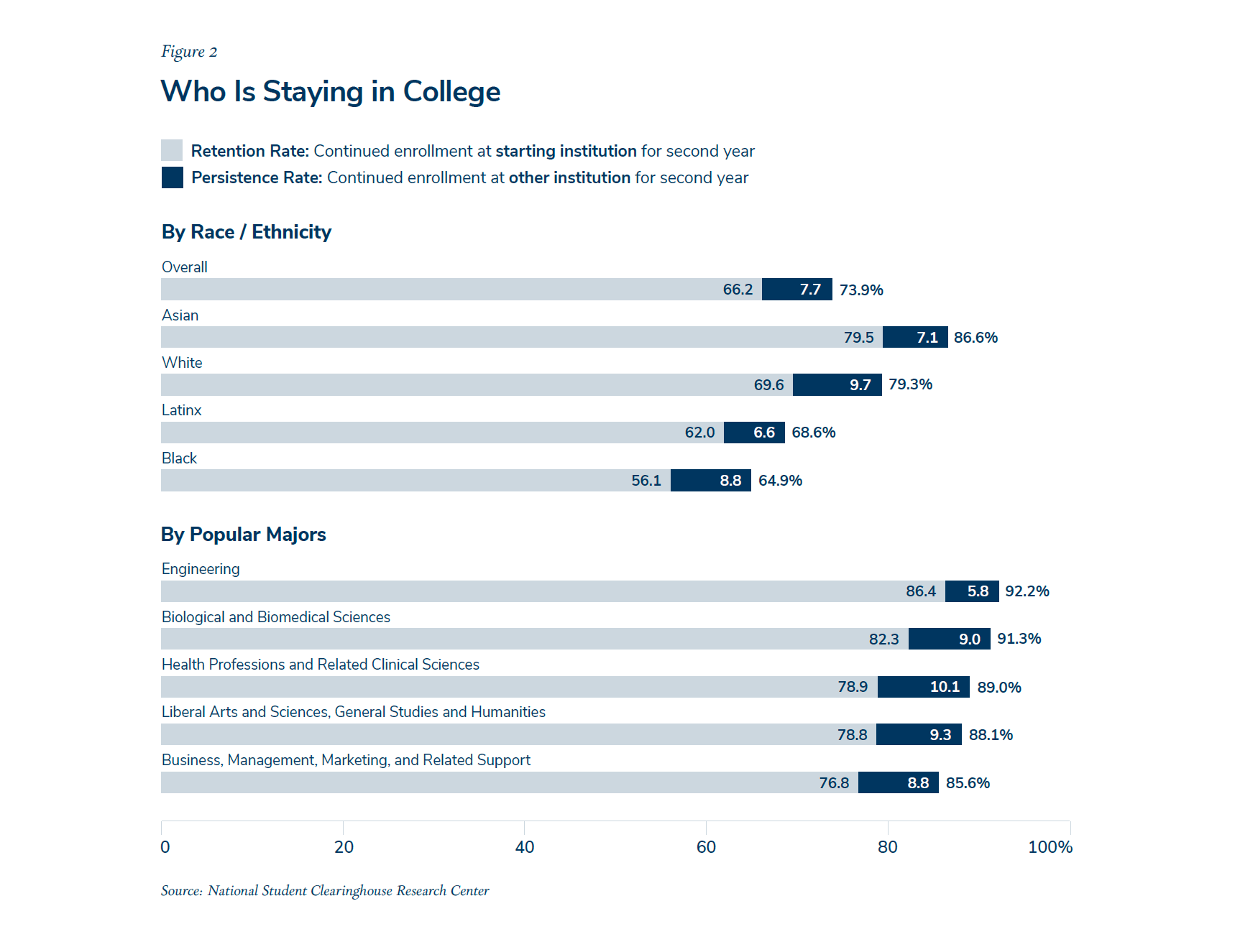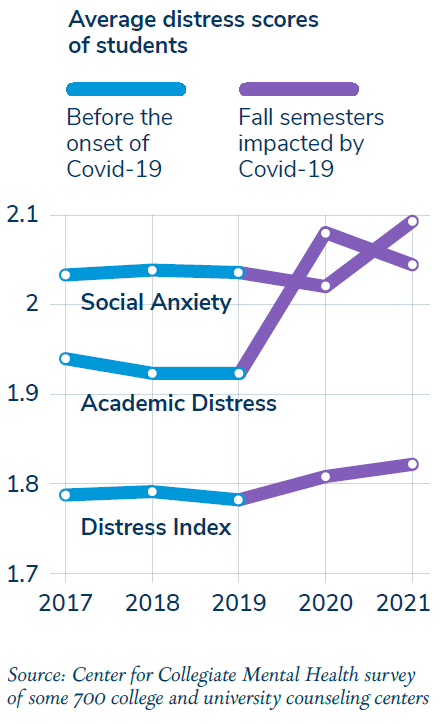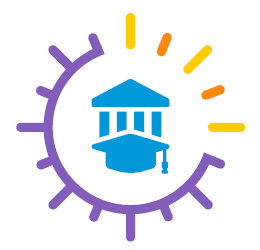The Great Reset
How Covid-19 Changed Student Enrollment and Engagement
and Where Higher Ed Goes From Here

After two years of disruptions from Covid-19 and the shift to remote and hybrid learning, college and university campuses are beginning to look more normal—or at least the new normal for higher education after the pandemic.
Still, as with much of our lives and the economy in general, the lingering effects of the pandemic will take years to work their way through colleges and universities. On nearly every front, higher education will feel the impact: enrollment, finances, student mental health, and workforce shortages, to name just a few. The learning loss in elementary and secondary schools, in particular, is something that will be felt in college classrooms into the next decade.
In the short term, the pandemic has left colleges facing twin crises: empty seats in classrooms and vacant beds in residence halls at the same time officials are dealing with alarming levels of disconnection among the students who remain on campuses.
Enrollment
Never before in the modern history of higher education have institutions confronted such a precipitous drop in enrollment as they have since 2019. The number of undergraduates fell by 3.1 percent, or some 465,000 students, between the fall of 2020 and 2021, according to the National Student Clearinghouse Research Center.
Overall, undergraduate enrollment dropped by some 8 percent during the pandemic. That translates into a million fewer students enrolled in colleges and universities. Undergraduates are “continuing to sit out in droves,” says Doug Shapiro, the executive director of the National Student Clearinghouse Research Center.
The hardest-hit sector is community colleges, which have lost more than 700,000 students during the pandemic. Adult students and men, in particular, make up the biggest losses at all types of institutions.

In the short term, the pandemic has left
colleges facing twin crises: empty seats in classrooms and vacant beds in residence
halls at the same time officials are dealing with
alarming levels of disconnection among the
students who remain on campuses.
Engagement
Before the pandemic, the pressure was on colleges to have higher graduation, better retention, and more engaged students. Decades of work was finally beginning to pay off as completion rates had risen slightly in the decade leading up to 2020. Now there is worry Covid-19 will reverse those gains.
Not only have students stopped out of college altogether, but surveys and anecdotal evidence from campuses show that those students still enrolled are missing classes, struggling to keep up academically, and checking out socially and in the classroom. A study from the Center for Collegiate Mental Health found self-reported feelings of social anxiety rose significantly in the fall of 2021. No wonder college presidents have said student mental health is their No. 1 concern coming out of the pandemic, ranking even above the financial sustainability of their institutions.

Re-Recruit, Re-Enroll, Re-Engage
For higher education institutions, acting decisively right now on a slate of student success approaches can boost engagement, retention, and help turnaround enrollment declines. For guidance, college leaders need only to look at those institutions that saw their enrollment largely remain steady during the pandemic.
“The colleges who lost the least were already focused on student success and knew how to engage students, including online,” says Josh Wyner, founder and executive director of the College Excellence Program at the Aspen Institute.
My research has identified a collection of three strategies colleges could employ to make up for lost ground on enrollment during the pandemic and practices to put in place that will make their institutions more student-centered going forward. I’m calling this strategy Re-Recruit, Re-Enroll, and Re-Engage.
Transfers among students age 18-20 were up significantly, some 14 percent, in the fall of 2021.
Re-Recruit
Under the re-recruit scenario, colleges look for students in the high-school graduating classes of 2020 and 2021 who showed interest in them until Covid-19 disrupted their college-going plans. Some of these students ended up never going to college, part of the one million undergraduates lost to the pandemic; others ended up shifting their plans in terms of choice of college during the pandemic and now may be interested in transferring as we enter a new normal. Indeed, transfers among students age 18-20 was up significantly, some 14 percent, in the fall of 2021.
Most of those transfers were among continuing students transferring from one four-year college to another (as opposed to those who were returning from a stop-out). Transfers were also up slightly from two- to four-year colleges for the fall of 2021—a pipeline that remains underutilized as source of students. More than 80 percent of community college students intend to earn at least a bachelor’s degree, but only about a quarter end up transferring.
One way institutions can improve the flow between two- and four-year colleges is to replicate the “Direct Connect” program at the University of Central Florida. It guarantees admission to the university for graduates of four community colleges in the state, including Valencia College and Seminole State College. Those two community colleges also share facilities with UCF, meaning that students never have to leave campus
to complete their bachelor’s degree.

Re-Enroll
The re-enroll scenario focuses on reducing the hurdles for students who stopped out during the pandemic, especially the one in four freshmen who started college in the fall of 2019 but didn't return to school the following fall.
One of the biggest hurdles to students’ re-enrollment at their original college or another one? Unpaid bills. Colleges rarely collect much of the money they’re owed. They average about 7 cents on the dollar when they send debts out for collection, according to Ithaka S+R, a nonprofit consultancy. In a study on what it calls “stranded credits”—academic credits that students can’t access—Ithaka S+R estimated U.S. colleges and universities are carrying $15 billion of unpaid balances on their books, which accounts for some 6.6 million students with stranded credits.
When Southern Methodist University started to dig into its data on unpaid bills during the pandemic, it found that the unpaid bills were disproportionately held by underrepresented students, especially low-income undergraduates. As part of a re-enrollment campaign during the pandemic, the university waived late fees “as a gesture to students,” says Wes Waggoner, associate vice president for enrollment management.
“There was a lot of benefit to waiving the fees, so we decided to make the policy permanent,” Waggoner says. “There are really good policy decisions to come out of this pandemic that will allow us to be a better place.”
Re-Engage
The changes that many colleges put in place during the pandemic—remote classes and physical distancing—and policies such as cameras off on Zoom and single rooms in residence halls mean that many students are ill equipped for the traditional college experience.
Helping students find a sense of belonging (Do I fit in here?) and
purpose (Why am I here?) is more critical than ever for colleges trying to re-engage students. “The long run is delivering what students came there for—a better life,” says the Aspen Institute’s Wyner. “It’s true of every student, at every college.”
And it’s particularly true for undergraduate men, whose enrollment fell nearly three times as much as female enrollment during the pandemic. The decline was the steepest—and the gender gap the
largest—among students of color attending community colleges.
Given that relationships are central to the higher education experience, colleges are increasingly not leaving them to chance. Kingsborough Community College in New York City pairs up new male students with high-achieving upperclassmen, who are paid for their work. California State Polytechnic University, Pomona is putting in place a new advising platform that tracks what they call “success markers”—critical courses that help students progress toward graduation. The university is also picking up the tab for students to retake one of those courses over the summer if they failed it.


Continued Agility
The pandemic forced institutions to radically and quickly rethink their operations—an agility that is essential in moving forward in resetting their enrollment and engagement policies permanently. My research and interviews with academic leaders, faculty members, and other experts revealed several important actions colleges should consider to maintain the momentum for change.
1. Organize data systems to quickly identify former students most likely to re-enroll. Because students can easily get lost in an institution’s byzantine requirements for earning a credential, they often don’t know how close they are to the finish line. It is critical to re-enroll those students who left recently and have the fewest credits left to graduate, yet most colleges lack the staffing to find those students and contact them.
That’s what Wake Technical Community College discovered several years ago when it estimated that staff members would need to compute 8 million comparisons by hand to match up students with their academic program requirements. So officials created an automated program that rapidly pinpoints students with unclaimed completed credentials and those close to completion. Armed with that data, college advisers reach out to students to suggest ways to complete a credential and get them re-enrolled. The data tool, Finish First NC, has since been deployed to other community colleges in the state.
During the pandemic, Wake Tech reached out to the students who were last enrolled in one of the previous three semesters and encouraged them to re-enroll (with an offer of a scholarship to cover a portion of the costs). Some 1,200 students were contacted; half of them were within 15 credits of completing a degree. As a result of the effort, 15 percent of the students registered for the spring semester.
“It’s not just about ‘Hey, why don’t you come back?’ “but rather ‘Why don’t you come back for the purpose of getting this degree,” said Scott Ralls, Wake Tech’s president. “It’s very deliberate. Once you map it out and show them how close they are, it becomes a more attractive proposition for students.”
2. Improve the student experience to reduce friction and meet students where they are. Colleges sell students on the experience, but during the pandemic it was difficult for campuses to differentiate their brand from another college’s when many students were at home or in their dorm room learning online or campus life was severely curtailed.
Students’ expectations have changed. They no longer want to stand in line at the financial aid office to get a question answered. They want access to digital course materials, so they don’t need to spend hundreds of dollars on textbooks. And they want flexibility in how they access classes.
Because of its experience during the pandemic, Georgia State University has moved permanently to a ticketing system for its financial aid call center, where students fill out information online and a representative calls them back knowing exactly what they need. As a result, the university has doubled the number of cases they resolve each day. What’s more, they’re no longer clogging up the phone lines with questions that are easy to resolve because those are filtered to the university’s chatbot, named Pounce (after the university’s mascot).
Ivy Tech Community College of Indiana was one of many
forward-thinking colleges that used the institutional share of federal coronavirus relief funds on long-term investments to lower college costs. Ivy Tech spent $10 million of federal aid on digital course materials that students can access no matter how many classes they take. Ensuring easier and less expensive access to textbooks and course materials was long a goal of Ivy Tech and the “pandemic demonstrated that students and faculty expected access to digital course materials,” said Sue Ellspermann, president of Ivy Tech.

3. Create stackable credentials and easy on and off ramps for students who want to ease back in. So much hasn’t been normal for students of all ages for two years. They may not want to rush back into a classroom. Colleges shouldn’t offer just their lineup of traditional programs and legacy degrees to the postpandemic learners.
Rather, this moment offers opportunities for colleges to offer students industry-recognized certificates alongside their traditional bachelor’s degree. West Virginia University, for instance, has identified multiple certifications that align with its bachelor’s degree program in health and well-being, for students interested in health science-related careers.
Des Moines Area Community College has expanded its noncredit programs to teach students just enough to start a career with a skills-based credential knowing they can come back to complete a degree.

The Path Forward
The Covid-19 pandemic was both a health and economic crisis but also one that interrupted learning on a scale never seen before in K-12 schools and on college campuses. But the pandemic pivots that colleges made, which upended decades even centuries of traditions, show that some approaches and practices institutions adopted can move the needle on student success. Right now, there is an opportunity for colleges to re-connect with the students they lost during the coronavirus, and if higher education adopts the right strategies going forward, it can ensure that the pandemic doesn’t claim a generation of students who are disengaged from learning.
This content is sponsored by Cengage. The editorial staff of Inside Higher Ed had no role in its creation.

ABOUT CENGAGE: Cengage, the U.S. Higher Education business of global education technology company Cengage Group, serves millions of instructors, learners, and institutions. Cengage delivers affordable, high-quality digital products and personalized support to power learning individually and at scale. Cengage’s customer-centered approach enables innovation, including Cengage Unlimited, the first and only all-access digital subscription for textbooks and course materials. Cengage’s textbooks, homework tools, and flagship online learning platforms, MindTap and WebAssign, help educators and students achieve their goals. Visit Cengage at www.cengage.com/institutions or on LinkedIn, Facebook, Twitter or Instagram.

